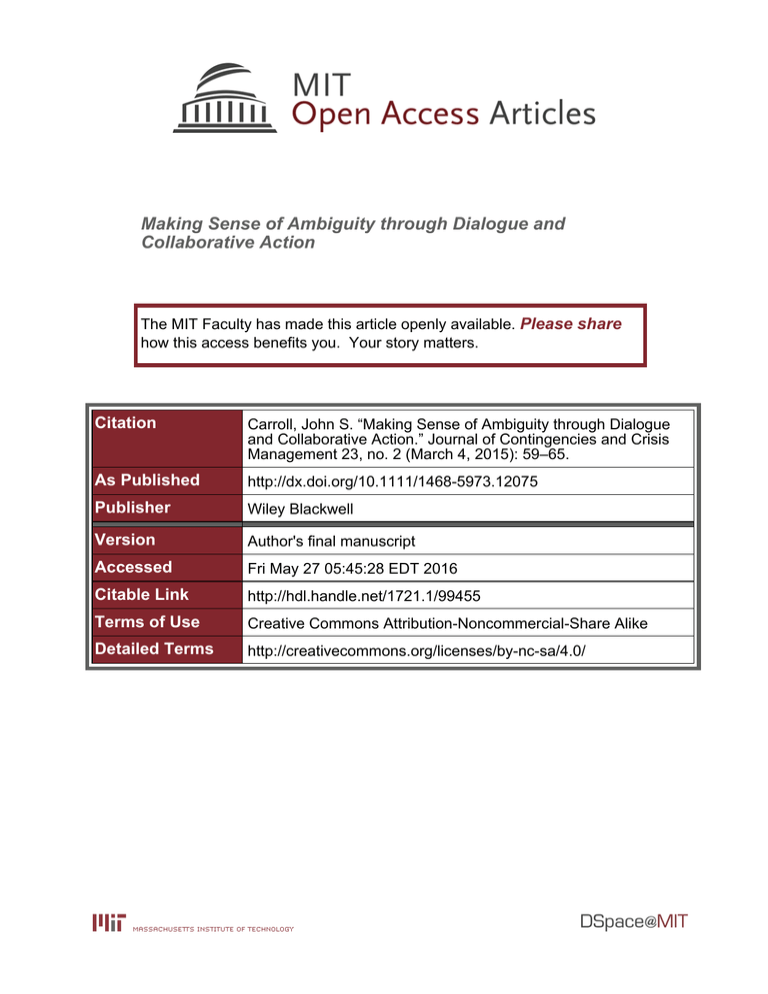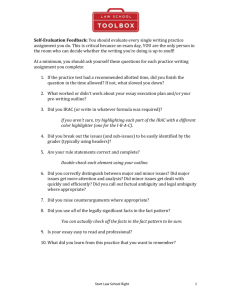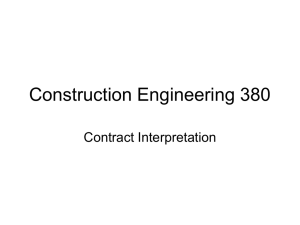Making Sense of Ambiguity through Dialogue and Collaborative Action Please share
advertisement

Making Sense of Ambiguity through Dialogue and Collaborative Action The MIT Faculty has made this article openly available. Please share how this access benefits you. Your story matters. Citation Carroll, John S. “Making Sense of Ambiguity through Dialogue and Collaborative Action.” Journal of Contingencies and Crisis Management 23, no. 2 (March 4, 2015): 59–65. As Published http://dx.doi.org/10.1111/1468-5973.12075 Publisher Wiley Blackwell Version Author's final manuscript Accessed Fri May 27 05:45:28 EDT 2016 Citable Link http://hdl.handle.net/1721.1/99455 Terms of Use Creative Commons Attribution-Noncommercial-Share Alike Detailed Terms http://creativecommons.org/licenses/by-nc-sa/4.0/ Making Sense of Ambiguity Through Dialogue and Collaborative Action John S. Carroll MIT Sloan School of Management Presented at the 8th International HRO Conference: Sustaining High Reliability University of North Texas Health Science Center March 28-30, 2014 Journal of Crisis and Contingency Management, 2015 Summary This paper outlines the importance of ambiguity in organizations that manager hazardous operations in a rapidly-changing environment. Three kinds of ambiguity are described: fundamental ambiguity of lacking categories and labels for understanding what is happening; causal ambiguity of lacking system understanding of cause-effect relationships that enable explanation, prediction, and intervention; and role ambiguity of agreeing on responsibilities. Examples of successful and unsuccessful ways that organizations deal with ambiguity are drawn from several industries. Although the most typical response is to avoid ambiguity or to seek a false clarity from confident leaders, more successful strategies engage diverse participants from inside and outside the organization to provide multiple perspectives and innovative suggestions that contribute to learning-by-doing. Learning Objectives 1. To be able to list and explain different kinds of ambiguity. 2. To be able to describe and compare examples of more or less successful ways of managing ambiguity. 3. To be able to recognize ambiguity in the workplace and apply the concepts and examples to argue for more effective ways to manage ambiguity. Audience This paper is intended for a diverse audience of practitioners, managers, policy makers, and academics. Making Sense of Ambiguity Through Dialogue and Collaborative Action John S. Carroll MIT Sloan School of Management Presented at the 8th International HRO Conference: Sustaining High Reliability University of North Texas Health Science Center March 28-30, 2014 Organizations that face significant safety hazards are challenged to operate with high reliability, especially when the risks are borne by high-status stakeholders. Hence, airlines and nuclear power plants are consistently put forward as models of high reliability (Perrow, 1984). Yet these organizations, along with all modern organizations, face growing complexity and a dynamic environment of constant change in technology, local and global competition, human resource availability, and public expectations. Complexity and change bring uncertainty and, even more importantly, ambiguity. Uncertainty and ambiguity have many meanings in science and everyday language. For this paper, uncertainty is a lack of precision around the probability of an identified event, whereas ambiguity is an inability to identify, classify, or understand an event. Hence, ambiguity is more general than and serves as a frame for uncertainty (March & Olsen, 1976; Weick, 1979). For example, nuclear power plants routinely assess the risks associated with various accidents. For the most part, the accident pathways or failure modes are known and the probabilities are assessed through some combination of experience and expert judgment. There is some uncertainty around those probability assessments that arises from variation in expert opinion, misestimation in extrapolating from one context to another, natural variability in every piece of equipment and the exact way it has been operated over time, and so forth. But these uncertainties are familiar and they can be estimated and combined; the rest is just math. However, the calculated accident probabilities hold only when the plant is operated within its design envelope, which is essentially a collection of assumptions positing that the plant is designed, built, and operated as intended. Yet accident investigations typically reveal that a trigger event (such as a human error) occurred in a context of plant defects, some known, some unknown; these defects led the trigger event to become a full-blown accident. In essence, there is not only uncertainly in the risk calculations, but also ambiguity in that some unknown number and type of things will be present that were not in the calculations. Inserting a generic “fudge factor” or “engineering margin” helps protect against ambiguity, but no one really knows whether the margin is adequate or not. Over time, with operating experience (especially when it can be shared across plants), we come to learn about what was not in the original calculations (e.g., the rush to consider tidal waves following the Fukushima disaster) and hence reduce ambiguity; however, at the same time plants are continually changing in equipment and operating practices, and also responding to cost pressures, regulatory dictates, loss of expertise with retirement, and so forth, which increase ambiguity. We have no easy way to measure, calculate, or understand whether the Comment [K1]: I really like inclusion of this, changing in, because it often gets neglected as a big source of ambiguity. plant is now safer or less safe, with more or less uncertainty or ambiguity than before. It may be useful to distinguish a few different kinds or areas of organizational ambiguity. I would start with fundamental ambiguity1 that is experienced when we lack categories for understanding our reality, or come to appreciate or fear that our current categories are lacking (cf., “equivocality” in Weick, 1979). Without labels or categories, we cannot even formulate a useful question beyond the most generic “What’s going on?” A second type would be causal ambiguity, when we have an understanding of categories, but we struggle to sort them into causal relationships (cf., ambiguity of means and ends in March & Olsen, 1976). In hindsight, it is easy to assign causality to accidents, such as identifying a human error or a misleading procedure, yet a list of root causes and contributing causes rarely provides a satisfactory understanding or an effective plan for improvement. We are far from having a complete understanding of the causes of accidents and therefore face considerable ambiguity in managing operational safety. A third type of role ambiguity (Kahn, et al., 1964; cf., authority ambiguity in March & Olsen, 1976) captures the challenge of who is accountable for what aspects of safety, and which stakeholders are or should be involved in any changes? Role ambiguity is related to goal ambiguity (cf., March & Olsen, 1976) in that different stakeholders often advocate different organizational goals (e.g., shareholder vs. stakeholder value); this tension is rarely resolved through purely logical argument. Ambiguity at Millstone Nuclear Power Station Northeast Utilities (NU), the largest electric utility company in New England, faced a crisis in the late 1990s (Carroll & Hatakenaka, 2001). All three units at the Millstone Nuclear Power Station were shut down and the US Nuclear Regulatory Commission (NRC) required a wide range of actions before they would allow the units to restart. Among those requirements was an unprecedented Order requiring Millstone to demonstrate a “Safety Conscious Work Environment” (SCWE) as a condition of restart. However, this label had never been used before, in any industry. The NRC provided little guidance regarding what would constitute a SCWE, how to produce it, or how to know whether Millstone had succeeded in creating it. Instead, the NRC Order required Millstone to hire an independent third-party consultant to certify that the organization had achieved a healthy SCWE. The entire nuclear power industry watched the situation (and some actively participated by lending help) with concern that they could face future regulatory requirements of a similar nature. This is a large-scale example of a regulatory tactic known as “bring me a rock.” The regulator requires something ambiguous; the plant produces something; the regulator says, “that’s not it” until eventually the regulator says, “that’s what I want.” I am in discussion with Karl Weick about calling this ontological, epistemological, or categorical ambiguity. For now, fundamental ambiguity is the working label. My deepest appreciation for comments on an earlier draft. 1 In the case of Millstone, NU initially moved ahead in predictable ways. They hired a new Chief Nuclear Officer from another utility, who made several moves to restructure Millstone and shift the culture. He held an all-hands meeting at Millstone to articulate his values of “two-way communication” and “doing the right thing.” He reshuffled the senior managers, demoting some of them, and bringing in a retired Navy Admiral to head Millstone. A SCWE team was formed with the VP of Operations in charge, and the Employee Concerns Program (ECP) was reenergized with a new Director who had worked for the Admiral. An external consulting group was hired to fulfill the SCWE certification process; they were sufficiently independent of NU to be acceptable to the NRC. They developed a definition of SCWE, as the ability of workers to raise2 safety and quality issues without fear of harassment, intimidation, retaliation, or discrimination, and the ability of managers to respond appropriately to those concerns. But several months into the change initiative, with enormous amounts of money being spent to upgrade the units and change the culture, it was evident that progress was much slower than hoped. Although there were some signs of change, the company was bleeding red as they not only invested in change but also had to buy electricity from other utilities to supply their customers while Millstone was shut down. No one knew what to do to speed things up or whether momentum would build somehow. Then they got lucky, but not in the ways we might predict. Several events occurred that illustrated that Millstone still had its old habits and thought patterns. For example, after two contract workers had raised safety and quality concerns, their manager fired them for doing poor quality work; senior Millstone managers then approved the firing. The Director of ECP immediately intervened (those who make safety allegations are legally protected from retaliation) and the CNO reversed the firing decision pending an investigation. Within days, the investigation revealed that the workers had been right about their allegations and there had been no grounds to fire them. This was a transformative event for many managers who had not accepted that anything was wrong at Millstone, including the VP Operations who was in charge of the SCWE effort yet admitted he had been “going through the motions”; they had blamed their shutdown on the NRC and denied the need to change. Because the CNO had responded well to this event (and there were other events in the same time period), there was an opportunity to hear multiple viewpoints and reflect on some harsh realities. This led to more engagement and energy, and the creation of specific teams, meetings, and measures to assess and enhance SCWE. A deeper understanding of SCWE and how to create and measure it developed over months and years, driven by broad engagement of employees from top to bottom as well as external assistance. NU’s CEO participated regularly in role-plays in Karl Weick notes that “raise” is itself an ambiguous term, used at Millstone for their SCWE definition, and now embodied in NRC policy guidance documents. 2 management training. Regular meetings of cross-department management teams monitored conflict areas on a daily basis and developed understanding and action possibilities. Individual contributors added innovations and ideas that were welcomed as positive contributions. The third-party consultant became a true partner, helping to craft ideas and plans and providing advice and coaching to managers. In about two years, NU was able to restart the newest and largest unit, a year later the next unit, and the oldest and smallest was decommissioned. The plant was later sold to another utility for a remarkably high price. Ambiguity Around the Meaning of “Safety Culture”? In an analogous way to Millstone, entire industries have faced the question of, “What is Safety Culture?” The label was created in the 1980s by the International Atomic Energy Agency in Vienna during their investigation of the Chernobyl accident (see review in Guldenmond, 2000). Again, the label was created to fill a gap – something had gone wrong at Chernobyl that was more than a technical issue, and more than human error. Instead, there seemed to be an inexplicable disregard for the fundamental principles of safety management. Test engineers, overriding the operators, shut off safety systems and deliberately placed the power levels at a point where the reactor was known to have a design problem that made it hard to control. Lacking a way to understand why this had happened, the report called it a failure of safety culture. Over time, multiple definitions arose to articulate the concept of safety culture. Almost concurrently, the concept of “safety climate” had also been circulating through the research literature (e.g., Guldenmond, 2000; Zohar, 2010). It is generally agreed that safety climate is worker perceptions of the priority given to safety. Safety culture is a much broader term, encompassing espoused values, beliefs, practices, and underlying assumptions (e.g., Reason, 1997; cf., Schein, 1999). Because safety climate is based around a relatively simple measurement technique, employee surveys, it holds a competitive advantage with managers looking for action opportunities and measurable results. Climate surveys became widespread in aviation, health care, nuclear power, and other industries, where they were often called safety culture surveys. Consider the recently formed Bureau of Safety and Environmental Enforcement (BSEE) that exercises regulatory authority over US offshore oil and natural gas. Formed in the wake of the 2010 Gulf Oil Spill, with blame shared among the oil company, the contractors, and the now-defunct government regulator, BSEE has developed its policy documents to include discussion of safety culture. One key document states that leaders and individuals “emphasize safety over all other competing goals.” Later in the same document, safety culture is understood as “appreciation for the importance of safety… for its integration and balance with competing performance objectives.” But what does this mean: How are we to understand whether safety is an overriding goal or to be balanced with other goals? Such ambiguity or equivocality may be resolved over time as people inside and outside BSEE wait to see what happens when decisions get made and things go wrong, when people get blamed or promoted. However, this ambiguity may remain if decisions provide no clear pattern and if key leaders and respected experts differ amongst themselves as they jockey for influence. At a nuclear fuel manufacturing plant, a safety culture survey has recently been administered twice, a year apart. The survey measures multiple aspects of safety culture, with most items taken from a survey developed by the Institute of Nuclear Power Operators (INPO); the survey in turn derives from work in several industries by Reason (1997) and others. Following the first survey, which revealed some lower scores on safety culture dimensions, the plant organized four teams to initiate improvement efforts. In the second survey, plant managers were expecting to see some positive impact of their efforts. Instead, the results were very similar to the prior year, even slightly worse. In particular, the dimension of “respect” (that people treat each other with respect, especially across hierarchical levels and departments) was somewhat lower, which surprised those who expected that the efforts of the “Respect” team would produce improvements. An explanation surfaced that the company had shifted their health insurance to the plan of their corporate parent in the weeks just prior to the survey administration. There had been many reports of people going to their doctors with their old insurance cards and being told they weren’t covered anymore, or had less coverage than before, and there were other inconveniences and confusions during the transition. Managers believed that workers might have answered the respect questions in this context, feeling that they had not been treated very respectfully during this transition. Of course, the connection between insurance coverage and safety is indirect at best. But this story illustrates the causal ambiguity in understanding what scores on a safety culture survey mean, what has influenced those scores, and what initiatives are likely to improve those scores. The safety culture survey, by itself, does not reduce ambiguity. A common failure mode is to use the readily measurable scores as a substitute for inquiry (Schein, 2013), based on the simplifying assumption that there are additive cause-effect relationships. Instead, the plant used a series of focus group interviews following the survey to discuss the results and to get specific examples and details of what the responses meant to workers, supervisors, and managers. Then, diverse teams could begin to assemble ideas about how to intervene and how to know whether progress was being made. This is a process of acting into an ambiguous situation: elevating a concern to receive attention, making resources available, and taking steps to gather information and engage broad participation in sensemaking and change initiatives. The Ambiguities of Incident Investigations Root Cause Analysis (RCA) is the label placed on a family of techniques for investigating incidents, accidents, problems, and so forth. Every industry uses some form of incident investigation, which can vary from one person spending a half hour to a multi-discipline team taking weeks or months to investigate and issue a report. There are famous reports on Piper Alpha, Clapham Junction, Herald of Free Enterprise, Three Mile Island, Challenger, Texas City, and so forth that have had tremendous impact on their industry and even across industries. The intent of RCA is to reduce causal ambiguity, i.e., to identify the causes of an accident or incident so that steps can be taken to manage risk and improve performance. However, the very label suggests there is a single “root” cause that can be identified. In the extreme, I visited one nuclear power plant that had a database of RCA investigations that required the report writer to enter a single root cause code in the database. I have called this “root cause seduction” (Carroll, 1995) because of the very human desire to find the root cause so we can fix the problem and turn our attention to other matters. Most people don’t like the feeling of ambiguity; this is especially acute in many managers and engineers, who like having answers to problems. [In contrast, many academics prefer having questions that require more research and become uncomfortable at the idea that a problem is solved or a theory is complete.] Interestingly, for those RCA investigations that go more deeply into causes, they typically find that equipment problems and human error are only the tip of the iceberg. Underlying issues around training, hiring, long-standing design flaws and backlogs of work, priorities and resources, work practices, and so forth begin to surface. And then the role ambiguity also surfaces: just who is responsible for these problems, and who is responsible for making it better? It is easy to blame someone at the “sharp end” (Reason, 1990) who had their hands on the equipment and made a mistake, but whom do we blame for cutting training budgets or delaying maintenance? Blaming the people above you in the organization can be a careerending mistake. Blaming the competitive environment, the pressures from Wall Street to produce earnings, the chronic task overload, or the lack of safety culture seem equally futile. Lessons for Managing Ambiguity Most people, including managers, shy away from ambiguity and uncertainty. The prospect of losses loom larger than equivalent gains, and ambiguity is experienced as a loss of control (Slovic, 1987). We know that people are willing to take 1000 times the risk for activities that they perceive as being in their control (e.g., driving a car, skiing) in comparison to those they cannot control (e.g., flying in an airplane). Hence, the public demand for safety from aviation accidents, nuclear accidents, and so forth. The typical response to ambiguity, as illustrated in the examples above, is to avoid it. People look for ready answers, including at-hand fixes such as training, blaming the individual at the sharp end, or writing more detailed procedures. Managers look to consultants to provide a recipe for improvement, or to confident CEOs (or former Admirals) who seem to have the answers, or at least the “right stuff.” In all the cases presented in this paper, initial ideas about problems and solutions were useless or wrong; ambiguity had to be accepted and addressed collectively, with new information emerging from feedback over time. At Millstone, a new CNO brought the right values and a genuine desire to engage with others, but that was too little to push the transformation against deep resistance. It was his acknowledgement of management mistakes and openness to ideas from multiple participants that accelerated the transformation. With safety culture efforts, the desire to monitor and manage by the scores is the most visible and least important part of culture change. Instead, it is the conversations and engagement of broad participation in understanding the organization and generating innovative ways forward, with continuing discussion to learn from these efforts. In RCA, the misleading search for “the root cause” can inhibit progress. Instead, it is the process of convening to investigate and learn, and then to discuss ways to improve, that offers the true benefit. As Weick (1979) pointed out, maintaining or even increasing diversity of thought is costly and uncomfortable in the near term, but better in the long run. It is another case of what is known in systems thinking as “worse before better.” Weick uses the term “equivocality” rather than ambiguity. It’s an evocative term because it suggests “equal voices” or multiple participants conversing with mutual interest and respect for diverse viewpoints. The ability to hold conflicting ideas in a conversation or in one’s mind is important to managing ambiguity. That includes the ability to take action without assuming that the action is correct. There will be feedback to test the assumptions underlying the action plan, so assumptions must be held lightly in order to be testable and changeable. This requires cognitive flexibility, faith in the process over time, and willingness to work with others who bring diverse viewpoints. References Carroll, J. S. (1995). Incident reviews in high-hazard industries: Sensemaking and learning under ambiguity and accountability. Industrial and Environmental Crisis Quarterly, 9, 175-197. Carroll, J. S. & Hatakenaka, S. (2001). Driving organizational change in the midst of crisis. Sloan Management Review, 42, 70-79. Guldenmund, F. W. (2000). The nature of safety culture: A review of theory and research. Safety Science, 34, 215-57. Kahn, R. L., Wolfe, D. M., Quinn, R. P., Snoek, J. D., & Rosenthal, R. A. (1964). Occupational stress: Studies in role conflict and ambiguity. New York: Wiley. March, J. G., & Olsen, J. P. (1976). Organizational choice under ambiguity. In J. G. March & J. P. Olsen (Eds.), Ambiguity and Choice in Organizations. Bergen: Universitetsforlaget, 10-23. Perrow, C. (1984). Normal accidents. New York: Basic Books. Reason, J. (1990). Human error. New York: Cambridge U. Reason, J. (1997). Managing the risks of organizational accidents. Brookfield, VT: Ashgate. Schein, E. H. (2013). Humble Inquiry: The Gentle Art of Asking Instead of Telling. San Francisco: Berrett-Koehler. Schein, E. H. (2009) The Corporate Culture Survival Guide (Revised). San Francisco: John Wiley. Slovic, P. (1987) The perception of risk. Science, 236, 280-5. Weick, K. (1979) The social psychology of organizing. Reading, MA: AddisonWesley. Zohar, D. (2010). Thirty years of safety climate research: Reflections and future directions. Accident Analysis and Prevention, 42, 1517-22.









